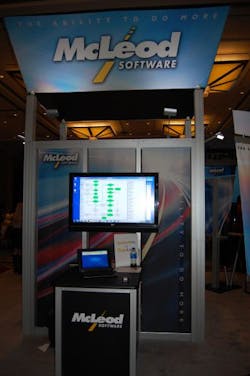Typically, during a “boom” in freight activity, trucking firms slack way off on their information technology (IT) investments. While they may have the money, when freight demand is hopping, they just don’t have the time to slow down and implement new IT systems to make their operations run more efficiently.
Thus, in the past, motor carriers would make IT investments during downturns – if they could afford them at all, of course – as that’s when trucking firms had the time and space necessary to implement new technology.
Yet that whole paradigm got turned upside down over the last four years or so in McLeod’s view as the industry has witnessed very slow but steady “incremental” freight increases.
“Not only has that given carriers the confidence to make [IT] investments, it’s given them the time to make those improvements as well,” he explained. “They’ve been making the kinds of technology changes and upgrades we typically don’t see until after a ‘boom’ cycle has passed.”
While McLeod added that it’s extremely rare for trucking companies large or small to “implement everything at once” in terms of modernizing their IT capabilities, here’s been a steady march by many to overhaul their so-called “legacy” systems.Indeed, McLeod is seeing more activity from LTL carriers in this regard over the last two years – a trucking segment his firm rarely interacted with previously.
“It’s a smaller [IT] market than truckload, but it appears to be an area of tremendous potential,” he said.
In fact, McLeod noted that among the top 100 TL and top 25 LTL carriers his company tracks, there seems to be in his words “an substantial effort to make a change” when it comes to IT system platforms.
“There are still a surprising number of midsize fleets that are under-utilizing the available technology, but significant opportunities remain – even among fleets that already have technology in place,” he pointed out.
So what does this potential widespread upgrade in the IT footprint of trucking carriers (TL, LTL or otherwise) mean to the industry as a whole?
Well for starters it would give the industry a much greater ability to divine which lanes – and which customers – are the best fit for their operations, driver needs, and pocket books … as well as which one are nickel-and-diming them to death.
Thus gaining to ability to truly know who the best customers are would give trucking a far greater ability to allocate capacity more profitability, especially since drivers are going to remain a very scarce commodity.
Indeed, Paul Newbourne – senior VP of logistics operations for Armada Supply Chain Solutions – addressed some of those very themes in a conference call earlier this year and how they will impact shippers.
“Many carriers have become much more sophisticated in how they operate,” he said. “They have a better understanding of their cost to serve a client’s business. Many of our carriers – including a number of the industry’s name brands – have told us that they are starting to become much more selective in the clients and freight they choose to handle.”Newbourne noted too that in one particular case a major carrier told him that they were pulling away from what the trucking company called “a very sizeable account” because of the detrimental impact that account’s operating practices had on their fleet’s efficiency.
Those aren’t new feelings, of course: carriers and drivers alike have long lamented how the demands of shippers negatively impact trucking’s bottom line in all sorts of unhealthy ways.
For example, in a separate panel discussion regarding how to deal with the Compliance Safety Accountability (CSA) program held at McLeod’s annual user forum, Dwight Bassett – senior VP and CFO for flatbed carrier Boyd Brothers Transportation – pointed out how just excessive detention time by itself creates a series of cascading problems his fleet.
“Driver turnover is one of the biggest safety factors we must deal with; we need to keep good, quality drivers in our industry,” he said.
“But look at how the cost of detention impacts drivers,” Bassett stressed. “Flatbed drivers will get paid for only seven to eight hours of work even though they are on duty for 14 solely because of detention time. If they can work nine to 10 hours, they’ll be able to make $60,000 to $70,000 a year. But that detention time prevents them from making money. We must put our foot down about that as an industry.”Fellow panelist Harry Kimball, director of safety for Transco Lines, echoed Bassett’s point even more strongly.
[FYI: Kimball is on the far right in the photo at left. Bassett is on the far left with Rob Bowman, president of R&L Truckload and wearing an orange shirt, sitting between them.]
“We need to look at the other half of the pie now,” Kimball stressed. “[Law enforcement] is focused on us but they allow shippers and receivers to do more damage to the 14 hour rule than we do.”
And how will the “other half of the pie” get looked at? Why through data of course – information gleaned from electronic logging devices [ELDs] and GPS data highlighting where trucks and drivers are detained for extraordinary lengths of uncompensated time.
And it’s also that kind of data that not only will allow carriers to do the easy math and cut such customers loose but should – only “should,” mind you, for we all know how fickle regulators can be – highlight in big, bold colors to enforcement officials who’s REALLY creating the HOS problems in the trucking arena.
So will McLeod’s so-called “surge” in trucking IT investment – if it can be called that – mark a broader strategic turning point in terms of when carriers begin to act on trucking’s tightening capacity environment in more decisive and permanent ways?
It very well could be – we’ll just have to wait and see.




